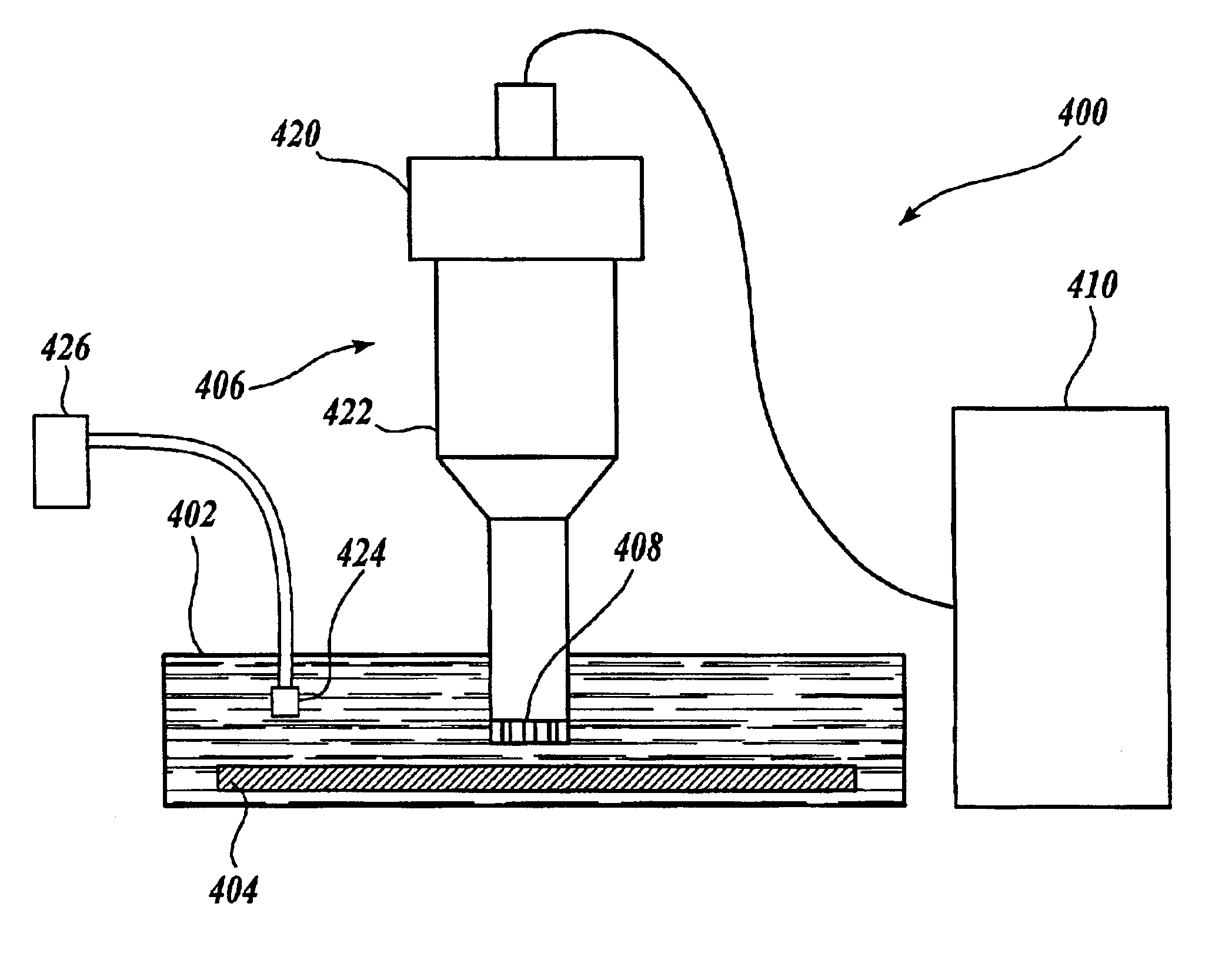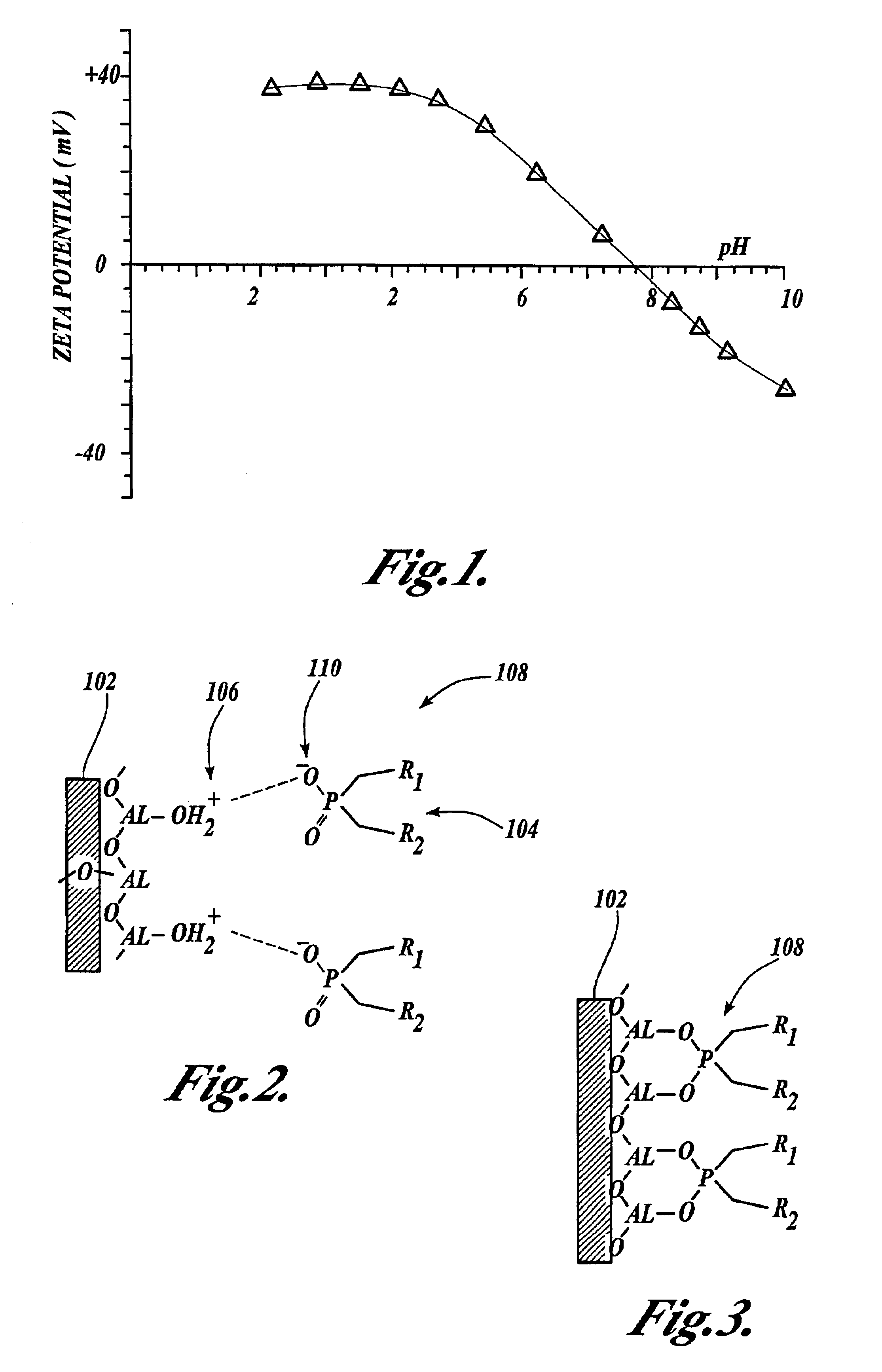Ultrasonic assisted deposition of anti-stick films on metal oxides
a technology of anti-stick film and metal oxide, which is applied in the direction of electric/magnetic/electromagnetic heating, mechanical vibration separation, instruments, etc., can solve the problems of difficult removal of plastic materials from metal or glass molds without damaging the surface finish or leaving undesirable residues on either the molding surface or finished product, and achieve the effect of inhibiting entry and/or adhesion
- Summary
- Abstract
- Description
- Claims
- Application Information
AI Technical Summary
Benefits of technology
Problems solved by technology
Method used
Image
Examples
example 1
Aluminum Alloys 6061 and 7075 were anodized so as to produce a 0.002″ thick alumina feature over the aluminum substrate. Alloy 6061 is comprised of 0.8-1.2% Mg, 0.4-0.8% Si, 0.15-0.40% Cu, 0.25% Cr 3 and alloy 7075 is comprised of 5.5% Zn, 2.5% Mg, 1.5% Cu, 0.3% Cr, 0.2% Mn A solution was prepared having 0.4% by weight Zonyl UR (an anionic phosphate fluorosurfactant produced by DuPont) dissolved in a 60 / 40 DI water / isopropanol. The solution was added to a benchtop Branson ultrasonic bath (Model No. 2510).
The fluorinated phosphate ester was deposited on the anodized aluminum with the aid of sonication using the Branson ultrasonic bath at 45° C. solution temperature and for a relatively long treatment time of up to 30 minutes. Following this treatment, water drops demonstrated a 110° contact angle, which indicates that a low surface energy coating was deposited.
As a control, untreated plates were treated only in room temperature water. The casting made between the water-treated anodiz...
example 2
Tooling Aluminum plates were milled to form casting cell molds. These plates were then anodized so as to produce a 0.001″ thick porous alumina structure over the aluminum substrate.
The phosphonic acid solution as described in Example 1 was poured into a shallow plastic container.
The mold plate was placed in the phosphonic acid solution and treated with a Misonix Sonicator Ultrasonic Processor XL-2020, 20 kHz equipment used in the USAD process as illustrated in FIG. 9. The anodized aluminum plate was translated beneath the stationary horn equipped with a ½ inch tip at a rate of approximately 0.25 inches / second. The water-alcohol bath was moved in a linear fashion along one edge of the anodized aluminum plate. Upon reaching the edge of the aluminum, the translation stage moved the bath ½ inch and the horn then passed over an untreated path adjacent to the first path. This stepping pattern was repeated until the desired workpiece surface was completely exposed to the sonication produce...
example 3
Tooling Aluminum plates were milled to form 0.030″ casting cell molds. Unlike the molds described in Example 2, the molds described below where not anodized. The finish of the molds were unpolished, machined surfaces with pores associated with mill marks and machining defects.
The phosphonic acid solution as described in Example 1 was poured into a shallow plastic container.
The mold plates were placed in the phosphonic acid solution and treated with a Misonix 20 kHz equipment used in the USAD process as described in Example 2.
All of the mold plates were heated to 85 C for 30 minutes immediately following the mold release solution treatment and the molds were assembled according to FIGS. 12 and 13. Following drying, the water contact angle was greater than 110 degrees.
The resin was prepared in the same manner as described in Example 2
Following the cure cycle, the molds were cooled to room temperature and opened. All of the treated mold surfaces demonstrate excellent release properties...
PUM
 Login to View More
Login to View More Abstract
Description
Claims
Application Information
 Login to View More
Login to View More - R&D
- Intellectual Property
- Life Sciences
- Materials
- Tech Scout
- Unparalleled Data Quality
- Higher Quality Content
- 60% Fewer Hallucinations
Browse by: Latest US Patents, China's latest patents, Technical Efficacy Thesaurus, Application Domain, Technology Topic, Popular Technical Reports.
© 2025 PatSnap. All rights reserved.Legal|Privacy policy|Modern Slavery Act Transparency Statement|Sitemap|About US| Contact US: help@patsnap.com



